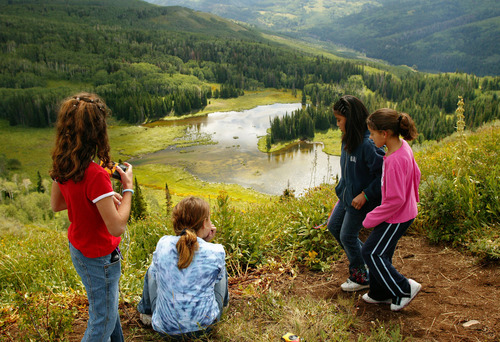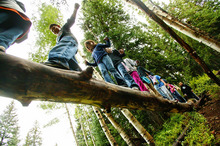This is an archived article that was published on sltrib.com in 2014, and information in the article may be outdated. It is provided only for personal research purposes and may not be reprinted.
The Mill Hollow Outdoor Education Center, run by the Granite School District, should be celebrating its 50th year of immersing students in the wonders of the wilds of the Uinta Mountains.
Instead, the district is scrambling to find funds to keep offering the popular summer tradition.
Shannon Bergmann's son Alex, a sixth-grader at Eastwood Elementary, went to the camp last August.
"When his friends saw the fliers they couldn't believe it might be closing," Bergmann said. "They all want their siblings to be able to go like they did."
The center's funding shortfall started with the 2011 Utah Legislature, said Ben Horsley, a Granite School District spokesman. Lawmakers stripped school districts of the authority to impose property tax levies for recreation facilities.
Granite found one-time money to carry the Mill Hollow program through 2013, but hopes of securing help from the Legislature have dissolved, Horsley said.
A group of supporters called "Team Mill Hollow" is trying to raise money to help the keep the facility open this summer, for at least a reduced number of students.
Roughly 3,800 district students attend two- or three-day camps at Mill Hollow each summer. Up to 200 kids a night participate in scientific studies related to nature, observe wildlife and hike. Some lessons involve geology, ecology, astronomy and the environment.
"It is an opportunity to be in the mountains and in nature and to understand all these interconnections we have with the earth and with each other," said Claudia Thorum, a longtime but now retired director of the center. "It forms bonds with nature, classmates and teachers."
District officials recognize the popularity and significance of the program, Horsley said.
"It is an excellent program that fills a niche, particularly with our lower-income students who do not always have the opportunity to participate in a wilderness experience," he said. "There are other ways to teach the curriculum. This program falls more in the want than in the need. Regrettably, our needs are pretty significant."
To find alternate funding, Horsley said, the district is in discussions with other school districts and the STEM Center in the Governor's Office of Economic Development, which supports science, technology, engineering and math initiatives. The district will also consider seeking sponsors.
The district would require roughly $350,000 to operate the Mill Hollow Center as it has been in the past, Horsley said.
One option would be to increase the $65 fee paid by students, but raising the full amount would boost that fee to about $250.
Such an increase would likely prevent most families from sending students. And "the bulk of the students" are from low-income families, qualifying them for fee waivers, Horsley added.
A deadline of March 31 looms for supporters to raise enough money to get the center open, hire staff and book reservations for this summer.
"Kids can put their hands in the water and see the wildlife for themselves," said Vickey Codella, who went to the education center in 6th grade, worked at Mill Hollow after high school and now teaches special education in the Salt Lake Valley.
"They are seeing things they can't see on an iPad; they are living the experience," she said. "That is a lasting form of education; one each of the students remember as a special experience."
If fundraising efforts fall short the center will not host students this summer, but it will not be shuttered and sold.
"The way our lease is set up with the Forest Service, it is cheaper for us to maintain the property at a cost of $150,000 a year," Horsley said. "There is a clause in the lease that would require us to turn the property back to the natural condition and that would require us to demolish the buildings and restore the area."
The thought of Mill Hollow without students is a sad one for Thorum. She loved hearing from students and teachers during their stays and after they had time to reflect on their experiences.
One such story is especially telling, she said.
"There was a little girl who could not afford to take a vacation. [Her family] told her their vacation was sending her to Mill Hollow with a disposable camera to share with her family when she returned," Thorum said. "The three days had a huge value to that girl and to her family."
Twitter: @BrettPrettyman —
Team Mill Hollow
A group trying to help raise funds to keep the Granite School District's Mill Hollow Outdoor Education Center open this summer have created a web page to accept donations. Visit http://www.indiegogo.com/projects/team-mill-hollow.





